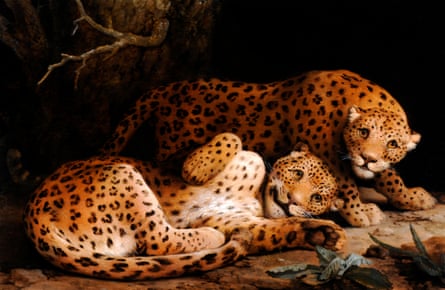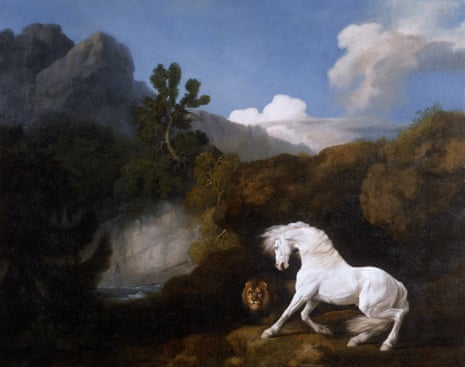A white horse trembles in terror, veins throbbing in its flanks, its mane thrust forward as if galvanised by electricity, its mouth open in shock. Every muscle of its tremulous body is a beacon of distress. As Horace Walpole, author of the Gothic horror story The Castle of Otranto, observed when Horse Frightened by a Lion was first exhibited in the 1760s, this poor, suffering animal expresses more with a fetlock than a poet with verse.
Animals are not dumb in the art of George Stubbs, nor are they the machines René Descartes claimed they were, nor stuffed specimens in a museum. The creatures in this exhibition look back at you. Their eyes are strange and unsettling – not human but conscious, curious, intensely aware. A lioness glares warningly. A mouse lemur’s huge eyes burst anxiously from its tiny body as it frets and frolics. A monkey gazes sadly from the darkness like a Rembrandt from another species.

George Stubbs, who was born in Liverpool in 1724 and died in 1806, is most famous today for his pictures of horses. In 18th-century Britain, racing was hugely popular and so was gambling. Racehorses were rock stars and Stubbs was their society portraitist. The same aristocrats who hired Joshua Reynolds to paint their wives or mistresses paid Stubbs to record their horses. Yet as this precise and moving exhibition in the beautifully preserved Georgian time capsule that is Bath makes clear, Stubbs is much more than a horse painter. He is a visionary of the natural world.
Even in his most routine commissioned works, he plainly liked animals far more than he liked their human owners. In a portrait of the Reverend Robert Carter Thelwell and his Family, painted in 1776, the year of the American revolution, the people are lifeless dolls trussed up in their best clothes. All the painting’s life is in Thelwell’s brown horse, which gleams with contained energy as it waits patiently for its gallop.

Stubbs wanted to paint something more ambitious than portraits. He wanted to create ambitious “history paintings” that told big stories of great moral significance. His 1762 picture Phaeton Attempting to Drive the Horses of the Sun is his first attempt to do just that: here Stubbs takes on a subject from Ovid’s Metamorphoses previously depicted by the likes of Michelangelo and Rubens and gives it his own eccentric twist.
When Michelangelo drew Phaeton, he had dwelt on the body of the doomed young man who foolishly thought he could drive the sun’s chariot, but got the horses wrong: Stubbs by contrast portrays the horses magnificently but his Phaeton looks completely unreal.

It is little wonder his horses are so accurate, for in the 1750s, after getting back to Britain from a mind-expanding stay in Rome, Stubbs shut himself away in a Lincolnshire cottage to dissect a horse. He drew this flayed and opened animal with the same compelling mixture of curiosity and compassion that puts Leonardo da Vinci’s human anatomical drawings among the world’s greatest works of art. The original dissection drawings by Stubbs exhibited here – from which he created his book The Anatomy of the Horse in 1766 – prove him the Leonardo of the horse.
Science and sympathy go together for Stubbs. His art is at once painstakingly accurate and spookily emotional. Cutting into that horse, it was as if he literally dug himself inside nature. He could see the world through a horse’s eye. This is what made his composition Horse Frightened by a Lion and its horrific sequel, Horse Devoured by a Lion, such revolutionary works of art. Stubbs painted his terrified horse repeatedly: the version here, lent by Liverpool’s Walker Art Gallery, is the most eerily beautiful, with its lush landscape that Stubbs based on Creswell Crags in Nottinghamshire, out of whose shadows the lethal lion approaches.

This is Romantic art, which opens up a completely new realm of feeling. Nature here is a place of wonder, revelation, dread and emotional profundity. Poetry lives in the wild. Everything comes together for Stubbs in this painted tale of animal terror – ambition for great themes, anatomical knowledge, acute observation – and leads him into even stranger realms of the wilderness.
Stubbs can put you in a lion’s den, where he portrays these predators snarling at each other in mutual rivalry, or in a tiger’s shaded hiding place. His great 1779 painting Two Leopards creates an even more intimate encounter: their black-spotted bodies fill the big painting with glorious abstract richness as they pose playfully, but it is their orange and brown eyes that eerily capture you.
In his illustrated poem The Tyger (1794) William Blake pictures a savage beast as a terrifying marvel of nature. Stubbs goes further and portrays his leopards as sentient, sensitive, acute observers that return our gaze. This is radical art from an age of revolution. Stubbs is one of the most subversive of all the great artists, and in our time his message matters more than ever. He urges us to see the world with other eyes; to empathise with our fellow creatures. This is not a huge exhibition, but it might just change your life.
- Stubbs and the Wild is at the Holburne Museum, Bath, 25 June to 2 October.

Comments (…)
Sign in or create your Guardian account to join the discussion